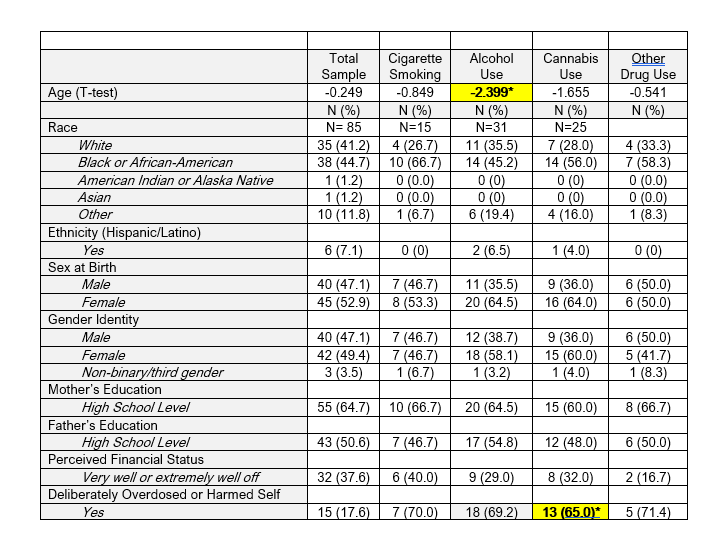Emergency Medicine: All Areas
Emergency Medicine 6
356 - Lifetime self-harm or intentional overdose and use of specific substances among adolescent patients in a pediatric emergency department.
Publication Number: 356.21

Carol Vidal, MD, PhD
Assistant Professor
Johns Hopkins University
Baltimore, Maryland, United States
Presenting Author(s)
Background:
Previous research has found associations of suicidal thoughts and behaviors with substance use in the general population1,2,3 and in patients screened in a pediatric emergency department (PED).1 To our knowledge, no studies have explored lifetime self-harm or overdose by specific substances used in a PED population.
Objective:
To describe associations between lifetime self-harm and overdose and lifetime substance use in a population of adolescent patients seeking services in an urban PED.
Design/Methods:
An online survey was administered to a convenience sample of 12- to 17-year-old patients seen in an urban PED for medical services. The survey queried whether participants had “ever deliberately taken an overdose (e.g., of pills or other medication) or tried to harm yourself in some other way (such as cut yourself)?” and lifetime use of cigarettes, alcohol, cannabis, and other drugs. Associations between lifetime self-harm or overdose with each type of substance use were examined using Chi-Square; p values < .05 were considered significant and < .10 are reported given the exploratory nature of the study.
Results:
Respondents (N=85) had a mean age of 14.8 years (SD=1.54). Most (44.7%) identified as Black or African-American race and 7.1% reported Hispanic or Latino ethnicity. Approximately one-half were assigned female sex at birth (52.9%) and identified as of female gender (49.4%).
More than 1 in 6 adolescents (17.6 %) had history of intentional overdose or self-harm and 42.4% reported any lifetime substance use. Lifetime cigarette smoking and alcohol use were reported by 17.6% and 35.5% of respondents, respectively. Lifetime cannabis use was reported by 29.4% and other illicit drug use by 14.1%. There were significant associations of history of overdose or self-harm with cannabis use (in 35.0% of adolescents with overdose/self-harm history vs. 13.3%, p= 0.032). Additionally, adolescents with a history of overdose or self-harm were more likely to report lifetime use of alcohol compared to those without such a history (30.8% vs. 13.0%, p=0.056). Rates of lifetime use of cigarettes, nicotine vaping, or use of other substances were higher among those with a lifetime history of self-harm or overdose, but the associations did not reach significance.
Conclusion(s):
Adolescents with a lifetime history of intentional overdose or self-harm were more likely to report lifetime substance use behaviors. Screening for specific substance use behaviors should be conducted for adolescents in PED with a history of intentional overdose and self-harm. 
